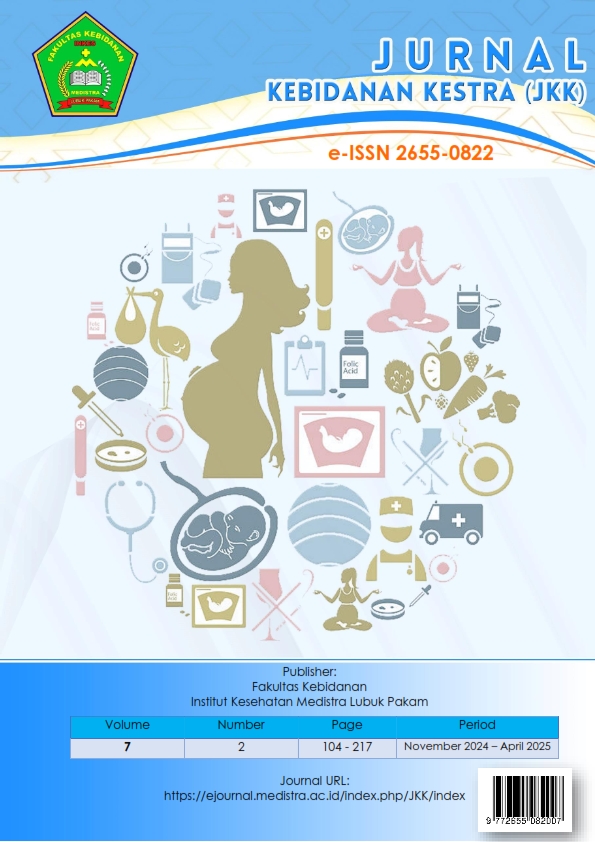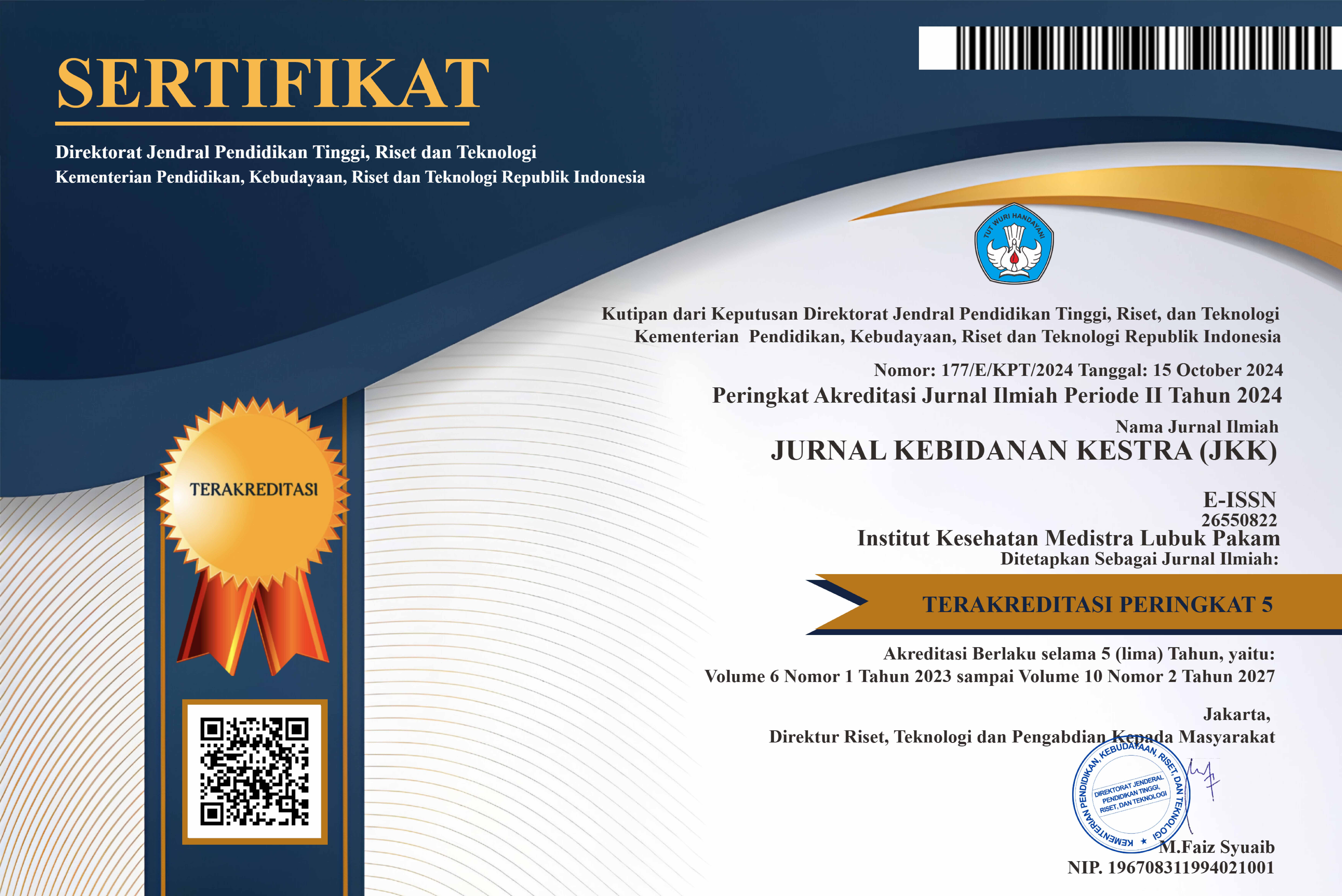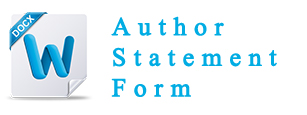The Relationship of the Incident of Obesity and Early Providing MPASI to Babies at the Juli Puskemas Juli District, Bireuen District
DOI:
https://doi.org/10.35451/jkk.v7i2.2629Abstract
Childhood obesity is defined as excessive accumulation of body fat, which can trigger various diseases. Exclusive breastfeeding is very important to prevent babies from gaining weight too quickly. The purpose of this study was to determine the relationship between obesity and early complementary feeding in infants. This study used an analytical approach with a cross-sectional study type. The sample in this study were respondents who met the established criteria. Sampling in this study used accidental sampling, with a sample of 42 respondents. The results showed that the majority of respondents were aged > 18 - 24 months, namely 14 respondents (33.33%) and were male, namely 25 respondents (59.52%). The majority of infants' weight was in the normal category, namely 41 respondents (97.62%). The majority of early complementary feeding was not given, namely 22 respondents (52.35%). Statistical analysis using Chi-square test obtained a value of ? (0.300) > ? (0.05), so there was no significant relationship between the provision of early complementary foods and the incidence of obesity in infants. The conclusion of this study is that there is no relationship between the incidence of obesity and the provision of early complementary foods. By increasing the knowledge of mothers about complementary foods through cooperation between educators and health institutions, it is expected to improve the nutritional quality of infants and support their optimal growth and development
Downloads
References
Y. Sari, A. Aryanti, and W. Afriani, “Perbedaan Berat Badan Bayi Yang Diberi Asi Eksklusif Dan Susu Formula Di Bpm Lismarini Palembang,” J. Kesehat. Abdurahman, vol. 12, no. 1, pp. 16–23, 2023, doi: 10.55045/jkab.v12i1.158.
Kemenkes RI, “Survei Demografi dan Kesehatan Indonesia 2023.,” 2023, Kementerian Kesehatan Republik Indonesia, Jakarta.
L. Arlenti, “Hubungan Pemberian Mp-Asi Dini Dengan Obesitas Pada Bayi Usia 0-6 Bulan Di Wilayah Kerja Puskesmas Pasar Ikan Kota Bengkulu,” J. Ilm. Kesehat. BPI, vol. 7, no. 1, pp. 16–20, 2023, doi: 10.58813/stikesbpi.v7i1.118.
I. Qanit and C. C. Bangsawan, “Pemberian Makanan Pendamping ASI Dini Meningkatkan Resiko Obesitas pada Anak,” J. Penelit. Perawat Prof., vol. 2, no. 1, pp. 91–98, 2020, doi: 10.37287/jppp.v2i1.46.
Chiara De Leonibus, “Update on Statural Growth and Pubertal Development in Obese Children,” 2012, Pediatric Report.
M. W. Andrian, N. Huzaimah, A. C. Satriyawati, and P. Lusi, “Pemberian Makanan Pendamping Asi Secara Dini: Hubungan Pengetahuan Dan Perilaku Ibu,” J. Keperawatan, vol. 10, no. 2, pp. 28–37, 2021, doi: 10.47560/kep.v10i2.291.
Liu, Introduction of Complementary Feeding Before 4 Months Age Increases the Risk of Childhood Overwight or Obesity; a Meta-Analysis of Prospective Cohort Studies. Hongkong: University of Science and Technology, 2013.
W. O. Nurul Mutia, “Edukasi Pemberian MPASI Dini Sebagai Faktor Resiko Kejadian Stunting,” J. Pengabdi. Kpd. Masy. Nusant., vol. 5, no. 2, pp. 2293–2298, 2024, doi: 10.55338/jpkmn.v5i2.3230.
S. Almatsier, Prinsip Dasar Ilmu Gizi. Jakarta: PT SUN, 2015.
R. Arsi et al., “Hubungan Pemberian Makanan Pendamping ASI(MP-ASI) Dini Dengan Status Gizi Dan Kejadian Diare Pada Bayi Usia 0-6 Bulan Di Puskesmas 7 Ulu Palembang,” J. Kesehat. Akper Kesdam II Sriwij. Palembang, vol. 12, no. 3, 2023.
WHO, Health for the World’s Adolescents: A Second Chance in the Second Decade. Geneva: World Health Organization Departement, 2014.
Ikatan Dokter Anak Indonesia, Penuntun Diet Anak. Jakarta: Badan Penerbit Fakultas Kedokteran Universitas Indonesia, 2015.
P. S. Pribadi, “Hubungan Antara Pemberian Susu Formula Dengan Berat Badan Lebih (Kegemukan) Pada Bayi Usia 6 Bulan,” J. Darul Azhar, vol. 6, no. 1, pp. 48–52, 2020.
R. A. D. Sartika, “Faktor Risiko Obesitas Pada Anak 5-15 Tahun di Indonesia,” Makara Kesehat., vol. 1, no. 1, pp. 37–43, 2021.
Muniandy dkk, “Pemberian Makanan Pendamping ASI dan Asal Usul Awal Risiko Obesitas: Sebuah Protokol Studi,” 2016.
C. T. Utami and H. S. Wijayanti, “Konsumsi Susu Formula Sebagai Faktor Risiko Kegemukan pada Balita di Kota Semarang,” J. Nutr. Coll., vol. 6, no. 1, pp. 96–102, 2020, doi: 10.14710/jnc.v6i1.16898.
Hajrah, “Gambaran Pengetahuan dan Sikap Ibu tentang Pemberian Makanan Pendamping ASI (MP-ASI) Dini di RB. Mattiro Baji Kabupaten Gowa Tahun 2016.,” Fakultas Kedokteran dan Ilmu Kesehatan Universitas Islam Negeri (UIN) Alauddin Makassar, 2016.
A. M. Nadhiroh, “Studi Fenomenologi Perilaku Pemberian Mpasi Dini Pada Bayi Usia 0-5 Bulan Di Wilayah Kerja Puskesmas Jagir Kecamatan Wonokromo Kota Surabaya,” Sinar J. Kebidanan, vol. 5, no. 2, pp. 42–54, 2023, doi: 10.30651/sinar.v5i2.20591.
Symon dkk, Langkah Pertama Hidup dengan Diabetes. Jakarta: Fundamental of Nursing, 2017.
Y. Hidayat, D. Nurmala, V. Susanti, S. Piaud, G. Putra, and I. Ciamis, “Analisis Dampak Pemberian Mp-Asi Dini Terhadap Pertumbuhan Bayi 0-6 Bulan,” Plamboyan Edu, vol. 1, no. 2, pp. 198–207, 2023, [Online]. Available: https://jurnal.rakeyansantang.ac.id/index.php/plamboyan/article/view/363
L. N. Wahdah and A. Ruhana, “Studi Kualitatif Mengenai Praktik Pemberian Makanan Pendamping ASI Dini di Dusun Paciran, Desa Paciran, Kabupaten Lamongan,” Nutr. Diaita, vol. 15, no. 02, pp. 67–78, 2023.
Downloads
Published
Issue
Section
License
Copyright (c) 2025 Intan Mandira, Debi Novita Siregar, Gracetika Jeny Chlaudya Simanjuntak, Ika Lestari Siregar, Julia, Imtihani

This work is licensed under a Creative Commons Attribution 4.0 International License.
Copyright in each article is the property of the Author.



























